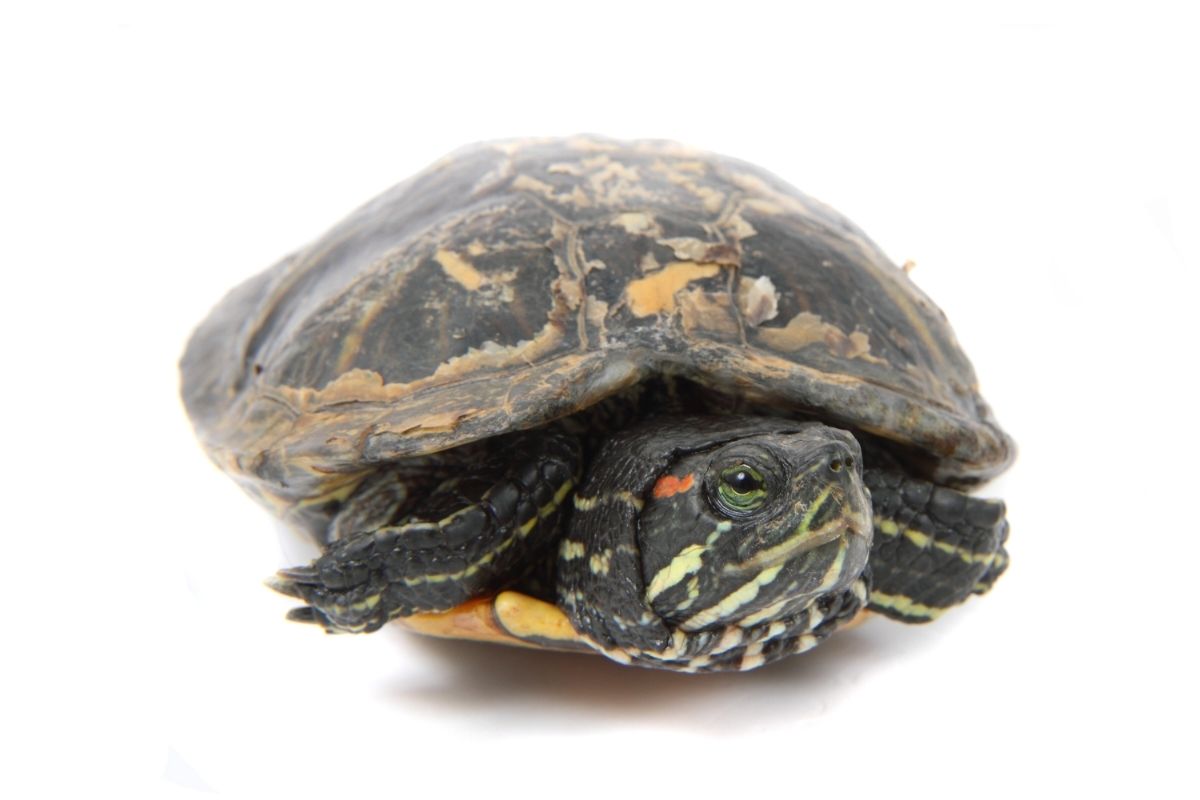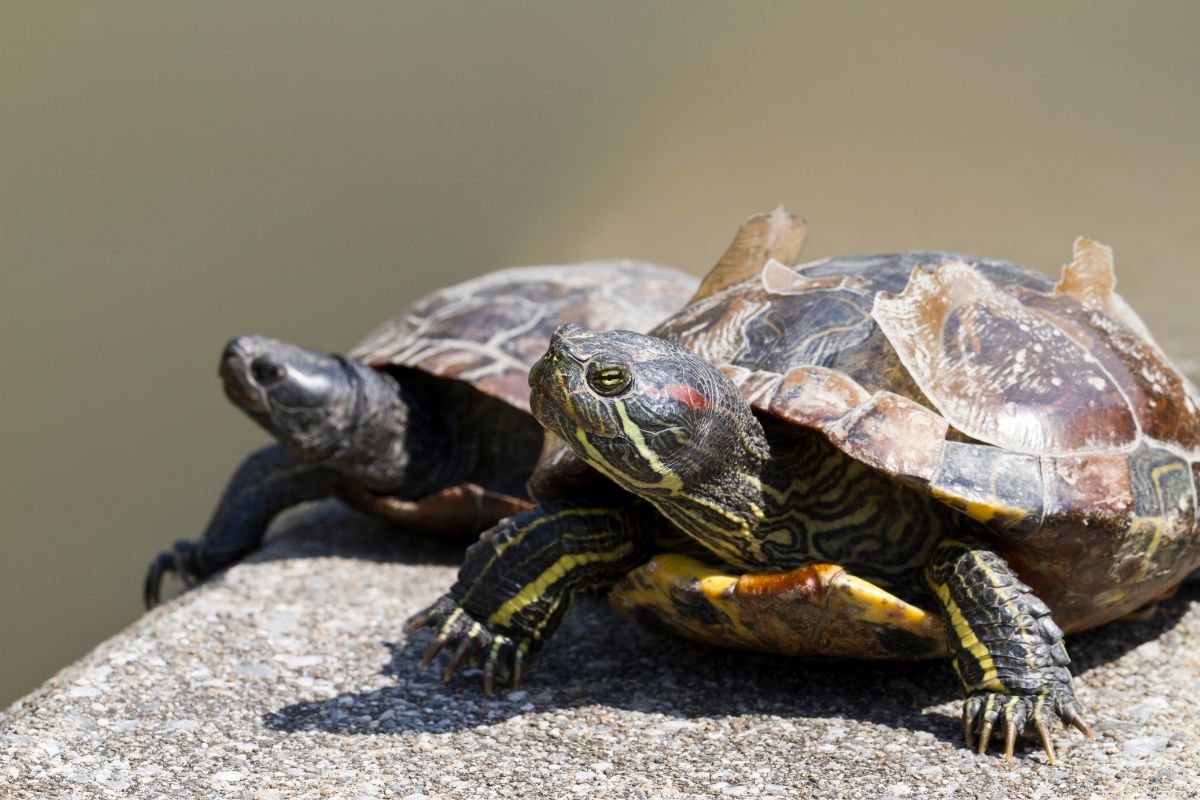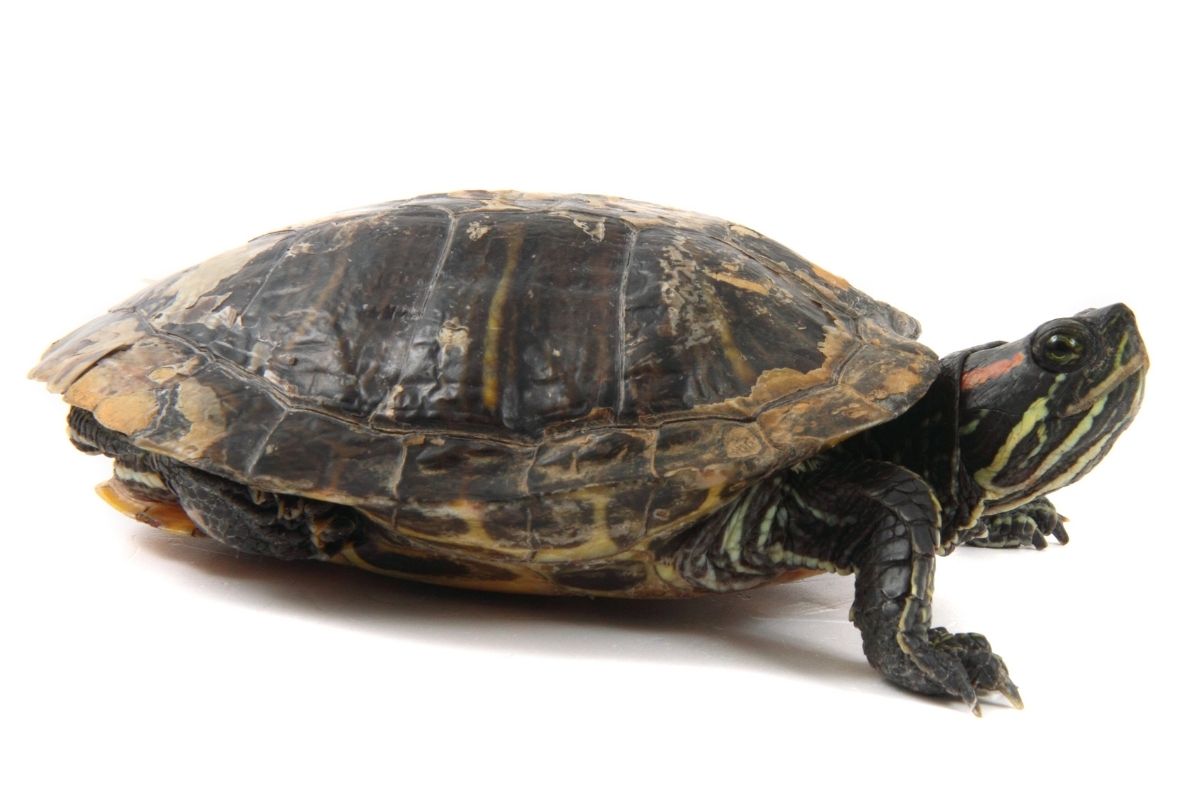You are not the only one who gets confused between shell rot and shedding when it comes to your pet turtle since they can look quite similar.
It is very important that you know the difference between these two things though because shell rot is a lot more serious than shedding and might even require your turtle to be taken to the vet.

What Is Shell Rot?
Also known as ulcerative shell disease, shell rot is the term given to an infection of the top half of the shell or carapace and is actually quite common. Shell rot can also be seen on the bottom half of the shell.
Symptoms
When a turtle is suffering from shell rot in the wild, their symptoms tend to be much more apparent than those that live in captivity.
In the wild, the turtle will have an overall poor body condition as well as dehydrated, and moss can sometimes cover the shell, which smells quite foul, paired with a bloody discharge.
For turtles that are in captivity, their symptoms will be a bit different. You might be able to see red fluid under their shell plates, and the shell might feel slimy.
The plates of the shell can lift or feel very soft and flaky, which makes the shell very vulnerable to damage. An unpleasant odor is also usually evident.
As shell rot gets worse, holes will start to become apparent underneath the surface of the shell, which looks like something has been eating your turtle, and over time, the shell will start to become uneven.
In severe cases of shell rot, nerves and bone can be exposed as shell plates start to fall off completely.
If the case is not too severe, then you will likely see that your turtle is still eating and has clear eyes with no other signs that they are ill, with only small sections of shell demonstrating shell rot.
In these circumstances, there will also not be any discharge or soft areas with the lesions or pits having white crusty deposits in them, which blend in with the rest of the shell.
Causes
There are a few things that can cause shell rot, one of which is the shell being damaged.
It might be hard to imagine that a turtle is fast and strong enough to hurt themselves, but they can damage their shells during fighting with other turtles.
Another way that a shell can sustain damage is if the habitat that the turtle is living in does not have the correct humidity or temperature, which can cause the shell to crack.
Bacterial and fungal pathogens can attack the healthy turtle’s healthy tissue that is underneath the shell, leading to shell rot.
If the substrate is too dry, the turtle’s shell and skin might get damaged, as they are meant to live in a humid environment.
Having said this, you should also make sure that the substrate is not too damp, as this can also cause shell rot because it makes the shell too soft, making it susceptible to infection.
To help your turtle regulate their body temperature and dryness, you should give them a good amount of space and the opportunity to climb out of the water so that they can dry themselves off.
Some obstacles and decorations are great for adding to your turtle’s tank as it makes things more interesting for them, but these objects should not have any sharp edges and should be placed in a way that prevents them from falling onto the turtle.
Their shell may be tough, but it is not that tough, and one wrong move might be the starting point for shell rot.
Living in a dirty environment is another cause of shell rot, so you need to keep the water that they swim in clean as well as the water that they drink out of.
A moldy, soggy bed is not nice to sleep on but also raises the risk of fungal or bacterial shell rot. Cleaning the bed regularly and keeping it dry will help prevent this from happening.
If you have a red-eared slider, the water needs to be filtered as their shells are softer and are, therefore, more prone to shell rot.
Turtles can be bitten by certain ticks, which can leave an open wound on your turtle and create an opportunity for harmful pathogens to enter their system.
Treatment
If the shell rot is not treated, the abscesses that occur will get worse and can even become an issue spanning several years, causing lots of damage to the tissue that may never heal.
Untreated shell rot can also lead to a very serious disease called septicemic cutaneous ulcerative disease, or SCUD for short.
This disease causes bacteria to grow in the bloodstream, which can become fatal if the bacteria are able to reach their vital organs.
Suppose the shell rot can be treated at home if it is not too serious. The first thing you have to do is figure out what caused the shell to rot in the first thing.
Therefore, cleaning the water, replacing the bedding, and taking out any sharp objects that may have caused damage. This includes taking out any other turtles that are in the same tank.
The turtle that is infected with shell rot should then be taken away from water and given a space to dry off until the shell has healed. Only when the shell is being cleaned, should the turtle get wet during this time.
To clean the shell, get a soft brush and gentle soap and use them to scrape off algae, dirt, or damaged parts that are on the outer layer of the shell plates.
After this, you can begin to scrape out the pits but should not be done if you cannot remove the debris easily. instead should wait for the shell to dry before trying again with a utensil.
The turtle should get at least 20 minutes of UV light every day, which can be done with a UV lamp or natural sunlight.
Keeping the turtle’s body temperature warm will help it heal faster and to do this, a heat lamp will work just fine.
Disinfecting the shell will help get clean it and get rid of the infection and the best solution to use is chlorhexidine.
Whatever you do, do not use hydrogen peroxide, as this can damage healthy cells and be detrimental to the healing process.
If your turtle is not showing signs of getting better after two weeks of at-home care, then you should take them to the vet, especially if the shell rot has gotten worse.
You should also take your turtle to the vet as soon as you can if you can see any wet areas on the shell with pus or stickiness, redness under the shell plates is another thing to look out for.
When the infection from shell rot gets this bad, your turtle may have to be anesthetized in order for the vet to be able to clean the affected areas and administer the antibiotics.
Prevention
If you witnessed what shell rot can do to a turtle in the past or are just learning about it now and are hoping you never have to see that happen to your turtle, then here are some ways that you can prevent it from happening.
It is good to know how to prevent shell rot from happening as it is much easier to make these changes now than to go through the process of trying to rid your turtle of the horrible infection, which can lead to very high vet bills if it is a particularly serious case.
As we mentioned in the section on what causes shell rot, we can use these causes to determine what we can do to prevent it.
For example, since shell rot can be caused by a dirty tank, you should make sure that you keep the tank and water clean, along with the bedding.
Keep a tab on the humidity and temperature of your turtle’s tank as well because if it is too dry, the turtle’s shell can crack and lead to infection, but if it is too damp, the shell can get too soft.
A soft shell not only makes your turtle more vulnerable but will also cause the shell plates to peel and leave room for pathogens to make their way underneath the shell.
A good, dry basking area that is near a heat lamp allows your turtle to dry off when they need to, and any sharp objects should be taken out of the tank as well to prevent damage to the shell and skin.
What Is Shedding?

Turtles have hard scales on their shells, also known as scutes, to make them nice and streamlined when in the water.
Scutes have a very similar composition to the keratin in our nails and are there to protect the bones of the shell that are located underneath.
Scutes also make the surface of the shell-less susceptible to infections and algae.
It is important that turtles do not have any algae on their shell because it can interfere with their body’s temperature as it prevents heat from getting in and will also make them move slower.
If you start to see these scutes peeling off, do not be alarmed because it is normal for turtles to shed this part of their shell.
Turtles shed their scutes as they grow in order to make room for bigger ones, but even if it is a natural part of being a turtle, it can sometimes be due to another underlying health condition.
When a turtle sheds their scutes, they like to eat it afterward, but this is not always a good idea for their digestion, so you should pick up the parts of the shell that have been shed throughout the tank.
As well as their scutes, turtles also shed the skin on their head and limbs as they grow.
This is natural and is usually no cause for concern, but if you notice redness, swelling, and white plagues, then there might be something more sinister going on.
Symptoms
There are some things that you can keep an eye out for that will tell you that your turtle is about to start shedding its scutes.
Your turtle might start rubbing their shell up against its tank and other objects in its habitat, which is done to help start the process of shedding.
You may also notice that your turtle is taking more time out of their day to bask in the warmth of their heat lamp because it helps to keep their shell nice and healthy throughout this process.
In some species of turtle, the shell can slightly change color as well as texture as it becomes thinner just before the shedding begins.
The shedding will typically begin with the scutes that are on the edges and bottom of the shell, with some scutes lifting and poking out in odd angles.
It may be tempting, but you should never peel these scutes off yourself, even if you think you are helping the turtle, because it can actually damage them instead.
Sometimes, the shedding process does not go very smoothly because algae attached to the shell prevents the scutes from peeling off.
If this is the case, then you are allowed to intervene and use scissors to gently cut the algae off of the shell.
The signs that your turtle is about to shed its skin are slightly different. The first thing you will likely notice is that the skin looks a bit dull to how it usually does because it is disconnected from the body.
The skin will peel off in parts; as with the shell, you should not peel it off yourself. If you see bits of dead skin in the tank that has been shed, it is advised to remove it from the tank to prevent it from clogging the filter.
Feeding your turtle a diet that is well-balanced and full of nutrients will be very beneficial, and make sure that your turtle still has a good appetite as it sheds.
Causes
Turtles shed their scutes as they grow and change shape so that they can make way for bigger, more effective scutes.
They also shed their scutes so that they can prevent any parasitic infections from taking hold of their shell and making their way further into their system.
Turtles shed their skin because they are going through a growing transition but sometimes, they shed because they suffer from a health issue.
Some possible issues are bacterial infections, too much vitamin A, thermal and chemical burns, and stress.
Shedding that is incomplete is a good indication that it was not part of a natural process and is usually due to the turtle not having enough moisture.
Treatment
Turtles shedding their scutes is natural and is only a cause for concern if your turtle has not shed them.
If the scutes are not being shed, then it could mean that the turtle is not growing properly, their habitat is not the right temperature, is malnourished, or does not have enough access to UV light
If your turtle is young, they will shed their scutes more than an older turtle would.
How To Tell The Difference Between Shell Rot And Shedding
So, how do you tell the difference between these two conditions?
The first place to start is by looking for any damage that has been done to the shell. You might see lifted plates, an unpleasant smell, and discharge from the shell.
As well as little white spots on the scutes that are falling off are all indications that your turtle is suffering from shell rot, not shedding.
If your turtle is an aquatic type and spends a lot of time in a humid environment, then they are more prone to shell rot, making it more likely that this is what they are experiencing.
Shell rot is not natural and is caused by fungal and bacterial infections, whereas shedding is completely normal.
You should not smell any foul smells or see any discharge when a turtle is shedding their scutes, and you must not interfere with the process in order to prevent accidentally harming your turtle.
If you are still not quite sure whether your turtle is struggling with shell rot or shedding, then there is no harm in taking them to the vet for a professional opinion – in fact, it might even save their lives.
Frequently Asked Questions

What Does Shell Rot Look Like On A Painted Turtle?
With a painted turtle, shell rot will be characterized by little white spots all over the shell. White spots on a painted turtle may also be due to a fungal infection or hard water exposure.
When a painted turtle has shell rot, these white patches on the shell will be pretty small but will soon form pits around them that can turn red as the shell rot is left untreated.
Why Is My Turtle’s Shell Turning Yellow?
Your turtle’s shell may be changing color or, in this instance, turning yellow because it is shedding its scutes.
This makes their shell change color because the shell that was underneath the old layer is fresher and more colorful.
But as these new scutes get exposed to the same environmental factors such as water, light, and air that the old ones were exposed to, they will turn to the same dull color, which is normal.
If it was not due to shedding, your turtle might be changing color due to an underlying issue.
For example, they might be experiencing a lack of UVB light, protein, and nutrients, as well as having hard water in their habitat, which can all cause the shell to change color.
Do Turtles Stop Eating When They Shed?
Your turtle should not stop eating when they are shedding, but this is not to say that it is abnormal for them to stop eating as they can go for a long time without needing any food.
You should feed your turtle every day when they are young and then every other day as they get more mature.
Summary
Shell rot is, unfortunately, quite a common infection, especially among aquatic turtles, which can prove fatal if left untreated.
On the other hand, shedding is a completely natural process that turtles go through as they grow and develop that does not cause any pain but may look a bit weird for a few days.
If you think your turtle may have shell rot or is shedding, then you should look through the different causes and symptoms covered in this article so that you can come to a clear conclusion as to what is going on with your turtle.
However, for peace of mind and a professional opinion from someone who can physically see your turtle, it is highly advised that you take a trip to the vet.
